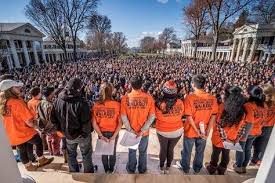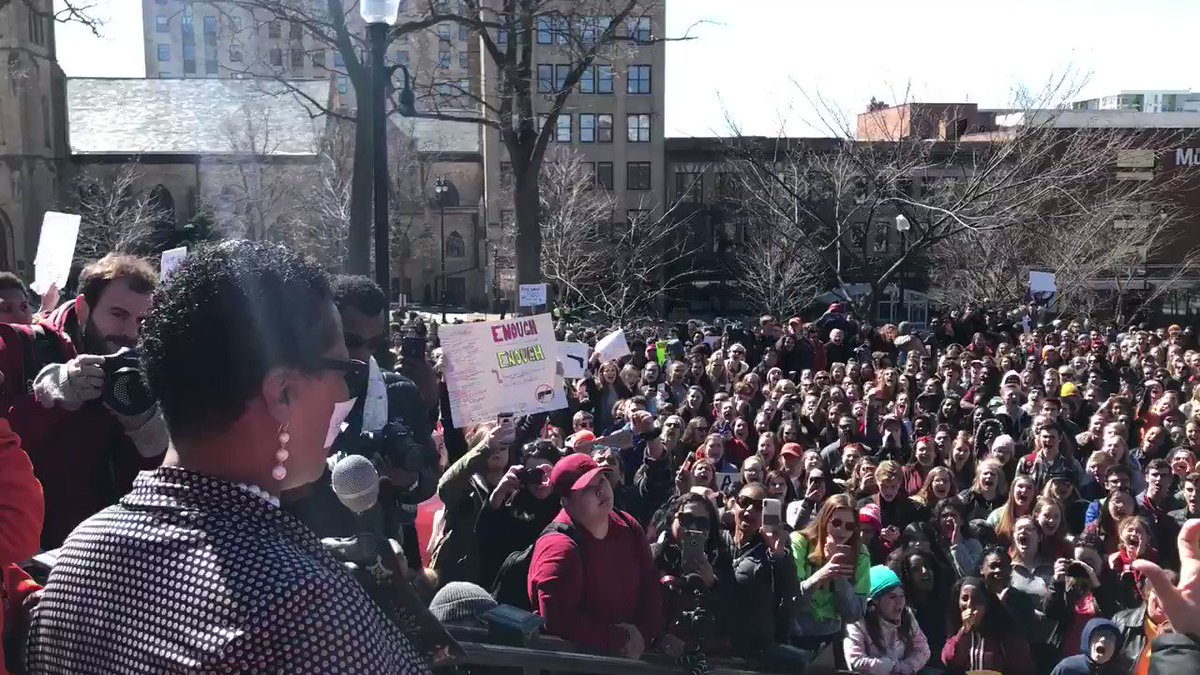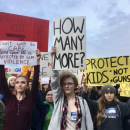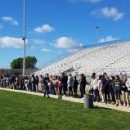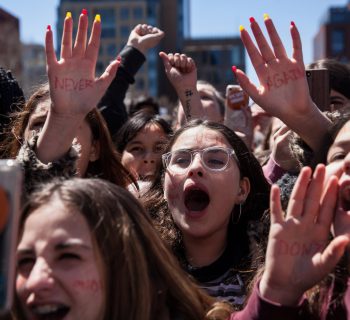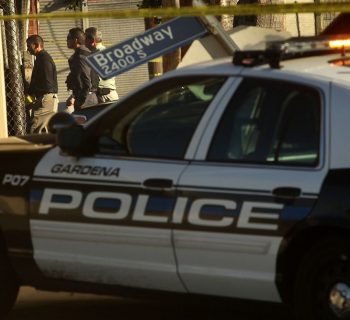College students around the country protested one month after the deadly Florida school shooting.
By Jeremy Bauer-Wolf ~ Inside Higher Ed ~ March 15, 2018
The bell at the University of Virginia chapel rang 17 times Wednesday morning -- one chime for each death in the Florida high school shooting that has launched waves of unprecedented activism among students nationwide. A crowd of more than 1,000 students and others splayed across the lawn there, silent amid the ringing.
Exactly one month after the Parkland, Fla., massacre, students across the country exited classrooms at 10 a.m., some quiet, some carrying signs demanding gun reform from lawmakers. The victims’ names were read aloud in places, at others chants arose: “It could have been us.”
Much of the media attention on the planned walkouts Wednesday has been focused on secondary schools, with debate over students’ First Amendment rights and whether they would be disciplined. At least 55 percent of high school students intended to walk out of classrooms, with 46 of those students saying they would do so even if it affected their college admissions, according to a Kaplan Test Prep survey.
Many colleges and universities have promised that if high schools suspended students for protesting, it would not be held against them in the admissions process.
Current college students also participated in these walkouts, with videos of the often emotional demonstrations appearing en masse online.
At Virginia, the Student Council sponsored the event that drew at least 1,500 people, in the estimation of the council president, senior Sarah Kenny. The council’s backing of the protest caused some displeasure among campus conservatives, who felt the council shouldn’t support such a politically charged issue, Kenny said.
“I stand firm in the position that gun reform and commonsense policies are necessary and inherently political,” Kenny said. “Furthermore the students in Parkland, they wanted this to be political to prevent another community being altered by such a tragedy.”
After opening remarks, some proposals were read aloud -- these were generated by the Never Again movement, spawned by the survivors at Marjory Stoneman Douglas High School, who also have been organizing the March for Our Lives later this month. The UVA council will try to coordinate buses to the march, Kenny said.
Kenny described the silence during the bell chimes as “deeply emotional” and a showing of student force on these issues. Students have felt relatively “helpless” in the political landscape, but the turnout proved there is a spirit that can carry beyond a single walkout, she said.
“I think that we have a wider variety of ages,” Kenny said of college students’ role in the movement versus the high school crusade. “And our institutions are seen as change agents in and of themselves, as bastions of knowledge. We have a collective of scholars, and these places are progressive on the front lines.”
In lieu of a bullhorn or shouts, participants at the University of Oregon observed 17 minutes of silence.
The College Democrats there helped organize the hushed protest, which attracted students, professors and parents with their young children, said Sophia DeLoretto-Chudy, a senior and vice president of the group.
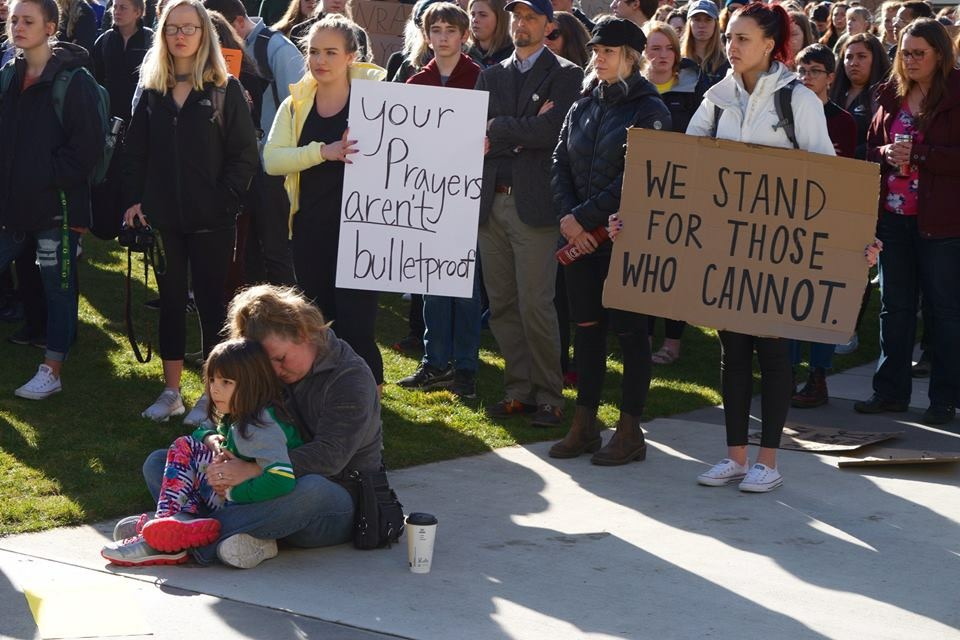
At an Oregon high school DeLoretto-Chudy’s sister attends, a group of teens tried to put together a walkout shortly after the shooting and were shut down by the administrators, she said.
DeLoretto-Chudy wanted to give those students some sort of outlet and show that the university supported their display, which eventually went on despite the objections of the high school, she said. The secondary students had been reprimanded for using official student government social media to advertise a walkout, so instead they took their message to their personal Twitter pages and Instagram, DeLoretto-Chudy said.
“When you see universities doing things like this, the high schools feel a little more empowered,” she said.
University of Oregon professors supported the college event, delaying classes 20 minutes and handing out excused absences, according to DeLoretto-Chudy, after which students returned to class. Oregon provost Jayanth Banavar told faculty that students would not be punished as long as they did not disrupt the campus.
The Parkland students were well positioned to speak out after the shooting because they come from a relatively affluent area of Florida, DeLoretto-Chudy said, and were able to galvanize their peers with fewer resources and capture the news media. Students have felt “disillusioned” following incidents of gun violence because it feels “like there’s a crisis every minute,” she said.
College students must serve as the vote for the high schoolers who can’t yet, DeLoretto-Chudy said, though she pointed out there’s much more of a move to register them early in many states. Gun violence has launched a new fervor around political activism, not just around gun policies, but even for elections that previously have gone unnoticed -- local races such as education boards and city councils, she said.
“It was a slow and steady progression,” DeLoretto-Chudy said. “It’s hitting way, way closer to home. We wake up with notifications; we see multiple headlines about school shootings. We wake up and Twitter is exploding. Snapchat quite literally has live videos of these walkouts -- that’s how we get our news, and it’s hitting really, really close to home for people.”
Indeed, Twitter feeds exploded Wednesday with footage from walkouts on both high school and college campuses. Snapchat’s map feature, which is usually stocked with footage of concerts and other major events around the country, was dominated by videos of high school walkouts everywhere from Washington State to the coast of North Carolina. Local press accounts noted walkouts at St. Lawrence, Georgetown and Northwestern Universities and the University of Nevada, Las Vegas. The protests weren't just confined to the campus grounds. University of Wisconsin Madison students took to the state capitol to protest, screaming for gun control and to raise the age to purchase a gun.
Source: Jeremy Bauer-Wolf ~ Inside Higher Ed

